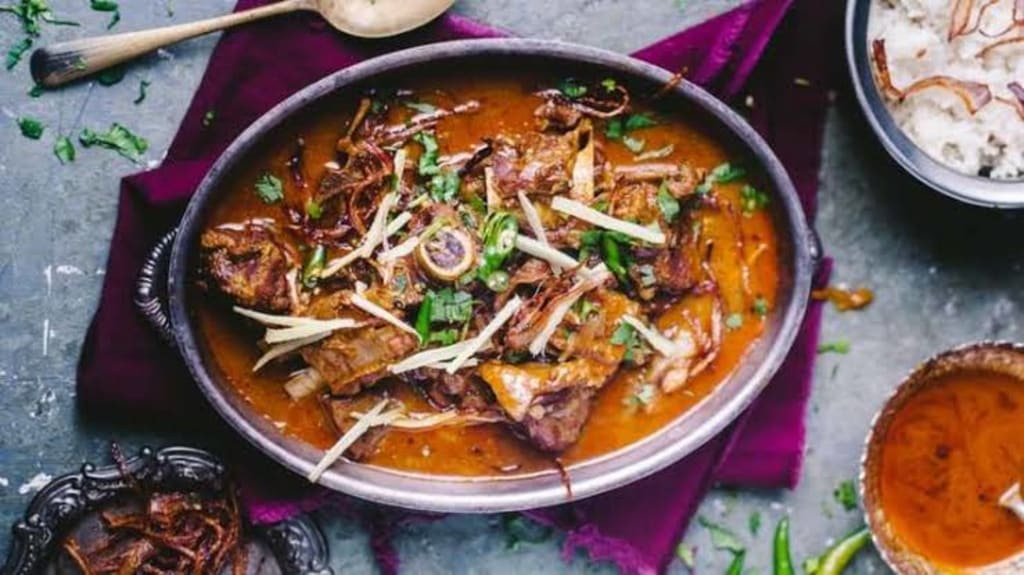
Introduction
Nihari, a dish that tantalizes the taste buds and warms the soul, holds a special place in the hearts of many in South Asia. This slow-cooked stew, rich in history and flavor, has become a symbol of comfort and culinary excellence. In this exploration of Nihari, we'll delve into its origins, preparation, regional variations, and cultural significance, uncovering the secrets behind its enduring popularity.
The Origins of Nihari: A Taste of History
Nihari's roots can be traced back to the Mughal Empire in the Indian subcontinent. The word "Nihari" itself is derived from the Arabic word "Nahar," which means "morning." This is because Nihari was traditionally prepared overnight and served as a nourishing breakfast dish, often enjoyed by laborers before a day of hard work.
Ingredients That Define Nihari
At the heart of Nihari lies its carefully curated blend of ingredients. While variations exist, the core components remain consistent.
Meat: Beef and mutton are the preferred choices for Nihari, with shank meat being a popular cut due to its rich flavor and tender texture. However, chicken and even vegetarian versions have emerged to cater to diverse palates.
Spices: Nihari's soul lies in its spice mix, which includes aromatic spices like cloves, cinnamon, cardamom, and bay leaves. These spices are toasted to release their essence before being incorporated into the stew.
Ginger and Garlic: Fresh ginger and garlic are crushed or finely minced to infuse the broth with their pungent flavors, adding depth to the dish.
Thickening Agent: Wheat flour or semolina is used as a thickening agent, giving Nihari its characteristic silky texture.
The Art of Preparation: Slow-Cooked Perfection
Nihari's preparation is an art form that requires patience and dedication. Here's a step-by-step guide to crafting this delectable dish:
Meat Marination: The meat is marinated with spices, ginger, and garlic, allowing it to absorb the flavors deeply.
Slow Cooking: The marinated meat is then slow-cooked for several hours, allowing the flavors to meld together. Traditionally, Nihari is prepared overnight for maximum richness.
Toasting Spices: The aromatic spices are toasted separately to enhance their fragrance and then added to the simmering stew.
Thickening the Stew: Wheat flour or semolina is mixed with water to create a paste, which is slowly added to the simmering pot to thicken the stew.
Regional Variations: A Culinary Kaleidoscope
Nihari's popularity has led to the development of diverse regional variations, each offering a unique twist on this beloved dish:
Delhi Nihari: This is often considered the original Nihari. It's known for its rich, spicy, and flavorful broth.
Karachi Nihari: Characterized by its vibrant red color and spicier profile, Karachi Nihari is a favorite in Pakistan's largest city.
Lucknowi Nihari: A milder version, this Nihari places emphasis on the meat's tenderness and uses fewer spices.
Hyderabadi Nihari: This variation incorporates a blend of South Indian and Mughlai influences, offering a unique and tangy flavor profile.
Vegetarian Nihari: Catering to vegetarians, this version replaces meat with vegetables or plant-based protein sources while retaining the rich spices and thick broth.
Cultural Significance: More Than Just a Dish
Nihari is more than just a culinary delight; it is deeply ingrained in the culture and traditions of South Asia:
Breakfast Tradition: Nihari has a long-standing tradition of being a breakfast dish, offering nourishment and energy for the day ahead.
Special Occasions: It's often served during special occasions, celebrations, and festivals, symbolizing warmth and hospitality.
Social Bonds: Nihari brings people together, fostering social connections and strengthening community ties.
Nihari Houses: Dedicated Nihari houses and restaurants are popular destinations, where people gather to enjoy this comforting stew.
The Universal Appeal of Nihari
Nihari's charm extends beyond South Asia's borders, captivating food enthusiasts worldwide:
Global Presence: Nihari has found a global following, with restaurants in various countries offering their own interpretations of this dish.
Adaptations and Fusion: Chefs have experimented with Nihari, creating fusion dishes and adaptations to suit different tastes.
Nihari: A Culinary Journey Worth Exploring
In conclusion, Nihari is more than just a dish; it's a reflection of history, culture, and the art of slow cooking. With its rich flavors and regional diversity, Nihari continues to captivate the hearts and palates of those who savor its warmth. Whether you're enjoying it in the bustling streets of Karachi or savoring a bowl in the comfort of your home, Nihari is a culinary journey worth embarking upon. So, the next time you encounter this delightful stew, remember the centuries of tradition and flavor that have gone into each spoonful, and savor the taste of South Asia's beloved Nihari.
About the Creator
Talha RJ
I JUST WANT TO GIVE YOU GUYS INFORMATION ABOUT SPACE AND MANY MORE THINGS THAT ARE HAPPENING AROUND US BUT JUST WE HAVE TO FOCUS ON THAT AND THAT IS WHY I AM AT YOUR SERVICE.






Comments
There are no comments for this story
Be the first to respond and start the conversation.